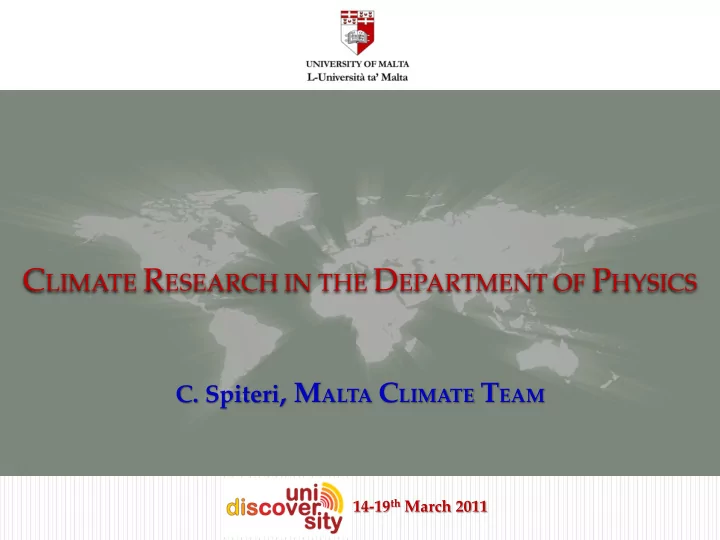

C LIMATE R ESEARCH IN THE D EPARTMENT OF P HYSICS C. Spiteri , M ALTA C LIMATE T EAM 14-19 th March 2011
A regional analysis of Australian climate in relation to ENSO using the PRECIS regional climate model
Contents: What is ENSO? Effect on Australian region Climate model validation 3
What is ENSO? El Niño/La Niña – Southern Oscillation is an oscillation of the ocean-atmosphere system in the Pacific Ocean. El Niño/La Niña defines differences in the sea surface temperatures. The Southern Oscillation is the atmospheric component of ENSO. 4
El Niño Phenomenon The first signs of El Niño event El Niño effects on Australia Rise in surface pressure Westerly winds Higher than average surface temperatures Lower than average rainfall 5
Southern Oscillation is measured by the Southern Oscillation Index (SOI) Negative SOI values represents El Niño events Positive SOI values represents La Niña events Current ENSO events Flooding over Brisbane capital of Queensland in January 2011 during current La Niña event. 6
Comparison of data Measured data extracted from 12 stations. Modelled data extracted from PRECIS RCM. Statistical Analysis: Correlation coefficient, R Meekatharra Airport Station analysis Table: Correlation value of temperature 1 2 3 4 5 6 7 Time frame Station 1960-1990 R 0.89 0.89 0.91 0.77 0.91 0.91 0.71 1990-2020 R 0.91 0.92 0.91 0.76 0.93 0.92 0.81 7
Comparison of Temperature at location of Meekatharra Airport Station. 8
Modelled and measured spatial plots of surface pressure Modelled Measured Spatial plots display a 30year average of a parameter. Modelled spatial plots extracted from PRECIS, measured spatial plots extracted from Data centres. Comparison of modelled and measured spatial plots 9
Conclusions • The E l N iño S outhern O scillation, ENSO phenomenon may be regarded as an oscillation of the ocean-atmosphere system • The modelled meteorological parameters which vary during El N iño events, pressure, wind, temperature and rainfall were compared to measured and analysed. • Negative values of the SOI, which measures the strength of the Southern Oscillation, inidcate El Niño events. • Analysis of annual time series for different parameters at specific locations revealed El Niño conditions. 10
Conclusions • The E l N iño S outhern O scillation, ENSO phenomenon may be regarded as an oscillation of the ocean-atmosphere system • The modelled meteorological parameters which vary during El N iño events, pressure, wind, temperature and rainfall were compared to measured and analysed. • ` Negative values of the SOI, which measures the strength of the Southern Oscillation, inidcate El Niño events. • Analysis of annual time series for different parameters at specific locations revealed El Niño conditions. 11
Conclusions • Different parameters were analysed over the whole domain by means of spatial plots and time series. • El Niño events are associated with an increased risk of dry conditions across large areas of Australia. • From results obtained, PRECIS showed what is expected. 12
Thank you E: cspi0015@um.edu.mt
Recommend
More recommend